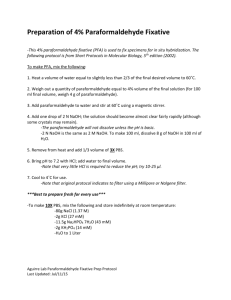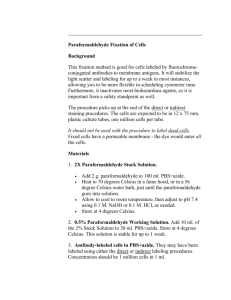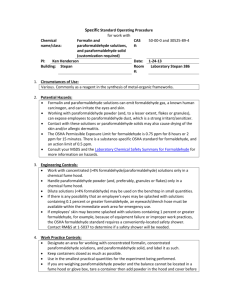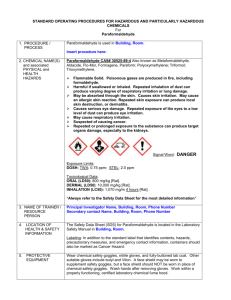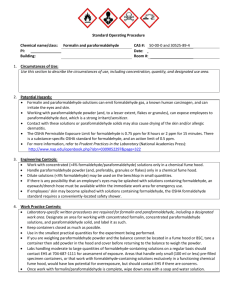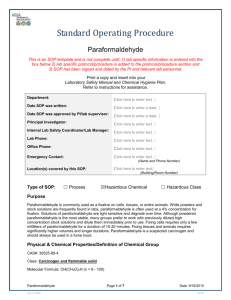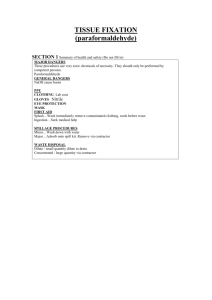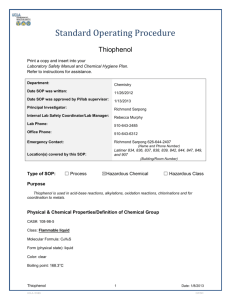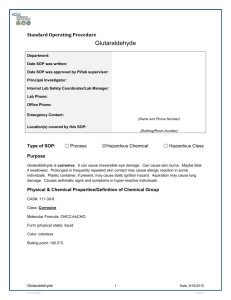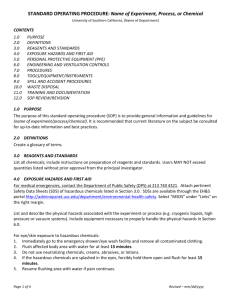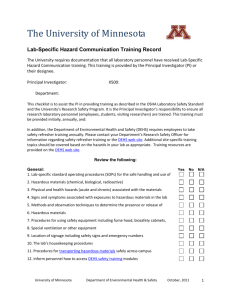Paraformaldehyde SOP
advertisement
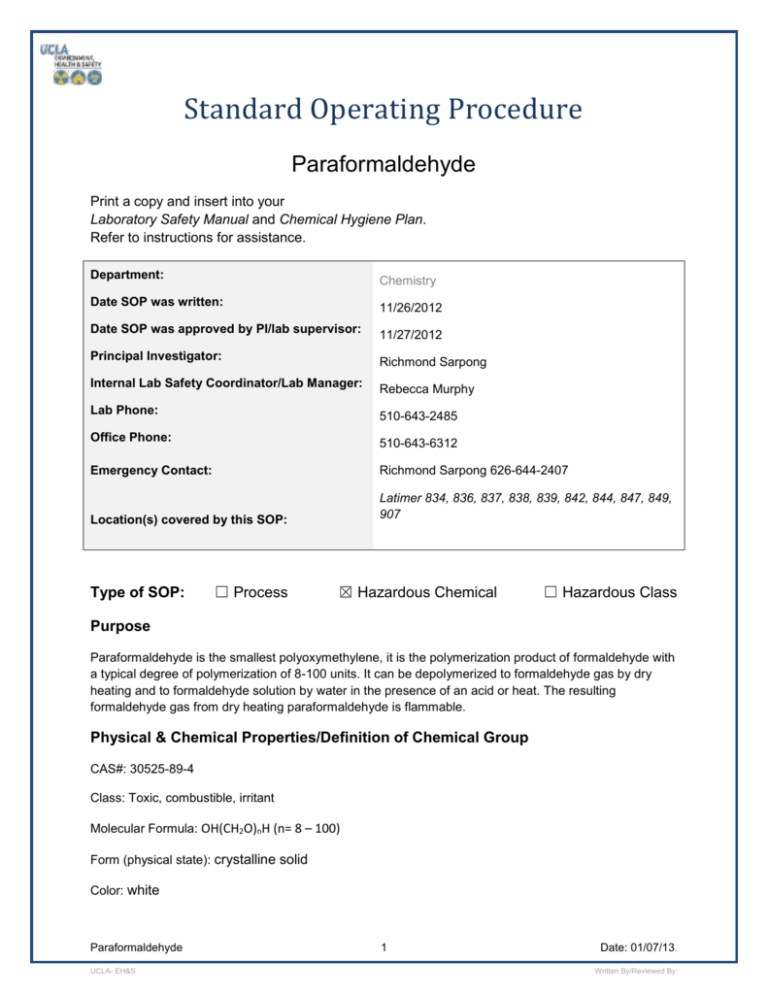
Standard Operating Procedure Paraformaldehyde Print a copy and insert into your Laboratory Safety Manual and Chemical Hygiene Plan. Refer to instructions for assistance. Department: Chemistry Date SOP was written: 11/26/2012 Date SOP was approved by PI/lab supervisor: Principal Investigator: 11/27/2012 Richmond Sarpong Internal Lab Safety Coordinator/Lab Manager: Lab Phone: Rebecca Murphy 510-643-2485 Office Phone: 510-643-6312 Emergency Contact: Richmond Sarpong 626-644-2407 Location(s) covered by this SOP: Latimer 834, 836, 837, 838, 839, 842, 844, 847, 849, 907 Type of SOP: ☐ Process ☒ Hazardous Chemical ☐ Hazardous Class Purpose Paraformaldehyde is the smallest polyoxymethylene, it is the polymerization product of formaldehyde with a typical degree of polymerization of 8-100 units. It can be depolymerized to formaldehyde gas by dry heating and to formaldehyde solution by water in the presence of an acid or heat. The resulting formaldehyde gas from dry heating paraformaldehyde is flammable. Physical & Chemical Properties/Definition of Chemical Group CAS#: 30525-89-4 Class: Toxic, combustible, irritant Molecular Formula: OH(CH2O)nH (n= 8 – 100) Form (physical state): crystalline solid Color: white Paraformaldehyde UCLA- EH&S 1 Date: 01/07/13. Written By/Reviewed By: Melting point: 120 ºC Flash Point 70 ºC Potential Hazards/Toxicity Acute Effects Hazardous in case of eye contact (irritant), of ingestion. Slightly hazardous in case of skin contact (irritant, sensitizer, permeator). Non-corrosive for skin. Non-corrosive to the eyes. Non-corrosive for lungs. Severe over-exposure can result in death. No listed Cal-OSHA Permissible Exposure Limit (PEL) Chronic Effects Slightly hazardous in case of skin contact (sensitizer) Mutagenic Effects Mutagenic for mammalian somatic cells. Mutagenic for bacteria and/or yeast. Mutagenic for mammalian somatic cells. Mutagenic for bacteria and/or yeast. Classified possible teratogen for humans. Developmental Toxicity Classified reproductive system toxin. The substance may be toxic to kidneys, liver, central nervous system (CNS). Repeated or prolonged exposure to the substance can produce target organs damage. Repeated exposure to a highly toxic material may produce general deterioration of health by an accumulation in one or many human organs. Paraformaldehyde: ORAL (LD50): Acute: 800 mg/kg [Rat]. DUST (LC50): Acute: 1070mg/m 4 hours [Rat]. For information on toxicity of related product likely present, formaldehyde, see https://www.dir.ca.gov/title8/5217.html Engineering Controls NOTE: Lab-specific information on engineering controls may be included in the Protocol/Procedure section. Work with regulated carcinogens should be conducted in a fume hood unless other controls are designated in the lab-specific Protocol/Procedure section. Sash height should be kept low to avoid escaping fumes and provide a physical barrier. There must be a designated area for working with carcinogens. This area must be appropriately labeled. The general procedures for working with regulated carcinogens are given in the EH&S document Carcinogens (EHS): http://www.ehs.berkeley.edu/hs/126-standard-operating-procedures-sop.html All operations involving formaldehyde and dilutions should be carried out in a certified chemical fume hood or a ducted Biosafety cabinet to keep airborne level below recommended exposure limits. Chemical fume hoods used as containment areas for particularly hazardous chemicals must have a velocity of 150 cfm, averaged over the face of the hood and must be certified annually. Paraformaldehyde UCLA- EH&S 2 Date: 01/07/13. Written By/Reviewed By: Laboratory rooms must be at negative pressure with respect to the corridors and external environment. The laboratory/room door must be kept closed at all times. Vacuum lines are to be protected by HEPA (high efficiency particulate air) filters or higher efficiency scrubbers. Personal Protective Equipment (PPE) NOTE: Lab-specific information on PPE selection may be included in the Protocol/Procedure section. Respiratory Protection NOTE: Lab personnel intending to use/wear a respirator mask must be trained and fit-tested by EH&S. This is a regulatory requirement. Refer to 8 CCR 5144 for selection of respirators. A respiratory protection program that meets 8 CCR 5144 must be followed whenever workplace conditions warrant use of a respirator. Respirators should be used only under any of the following circumstances: As a last line of defense (i.e., after engineering and administrative controls have been exhausted). When Permissible Exposure Limit (PEL) has exceeded or when there is a possibility that PEL will be exceeded. Regulations require the use of a respirator. An employer requires the use of a respirator. There is potential for harmful exposure due to an atmospheric contaminant (in the absence of PEL) As PPE in the event of a chemical spill clean-up process Hand Protection Handle with gloves. Gloves must be inspected prior to use. Use proper glove removal technique (without touching glove's outer surface) to avoid skin contact with this product. Dispose of contaminated gloves after use in accordance with applicable laws and good laboratory practices. Wash and dry hands. NOTE: Lab-specific and chemical-specific information on glove selection may be included in the Protocol/Procedure section. Refer to glove selection from the link below: For glove selection, go to: http://ehs.berkeley.edu/hs/63-laboratory-safety/94-glove-selection-andusage.html Eye Protection Tightly fitting safety goggles. Use face shield (8-inch minimum) when appropriate (not protected by fume hood sash for example). Use equipment for eye protection tested and approved under appropriate government standards such as NIOSH (US) or EN 166(EU) or ANSI Z87.1. Paraformaldehyde UCLA- EH&S 3 Date: 01/07/13. Written By/Reviewed By: Skin and Body Protection Long pants, closed-toed and closed-heeled shoes, cotton-based clothing/attire, and lab coat must be worn for protecting against chemical hazards. Hygiene Measures Handle in accordance with good industrial hygiene and safety practice. Wash hands before breaks and at the end of workday. First Aid Procedures Notify supervisor and EH&S immediately. Follow up with a call to 510-642-9090 to report the incident. If inhaled Move person into fresh air. If not breathing, give artificial respiration. Immediately consult a physician. In case of skin contact Take off contaminated clothing immediately. Wash off with soap and plenty of water for 15 minutes. Take victim immediately to hospital. Consult a physician. In case of eye contact Rinse thoroughly with plenty of water using an eyewash station for at least 15 minutes, occasionally lifting the upper and lower eyelids. Get medical aid immediately. If swallowed Do not induce vomiting unless directed otherwise by the SDS. Never give anything by mouth to an unconscious person. Rinse mouth with water. Consult a physician. Special Handling and Storage Requirements NOTE: Lab-specific information on handling and storage may be included in the Protocol/Procedure section. Working alone Certain extremely hazardous operations should not be performed if the PI or Lab Safety Contact(s) are not present. Never work alone with extremely hazardous materials/operations. See the Protocol/Procedure section below for specific prohibitions (if any) on working alone. Storage It is essential that all regulated carcinogens be stored separately from all chemicals with which they may react. Ensure segregation of incompatible chemicals per guidance within EH&S guidelines. Also, follow any substance-specific storage guidance provided in Safety Data Sheet (SDS) documentation. This is particularly important for regulated carcinogens as human exposure must be avoided. Spill and Accident Procedure Chemical Spill Dial 911 NOTE: When working with regulated carcinogens it is important to take immediate steps to prevent human contact with the spilled materials. Immediate action is required. Paraformaldehyde UCLA- EH&S 4 Date: 01/07/13. Written By/Reviewed By: Spill – Assess the extent of danger. Help contaminated or injured persons. Evacuate the spill area. Avoid breathing vapors. If possible, confine the spill to a small area using a spill kit or absorbent material. Keep others from entering contaminated area (e.g., use caution tape, barriers, etc.). Small (<1 L) – If you have training, you may assist in the clean-up effort. Use appropriate personal protective equipment and clean-up material for chemical spilled. Double bag spill waste in clear plastic bags, label and take to the next chemical waste pick-up. Large (>1 L) – Dial 911 and 510-642-9090 for assistance. Chemical Spill on Body or Clothes – Remove clothing and rinse body thoroughly in emergency shower for at least 15 minutes. Seek medical attention. Notify supervisor and EH&S immediately. Follow up with a call to 510-642-9090 to report the incident. Chemical Splash Into Eyes – Immediately rinse eyeball and inner surface of eyelid with water from the emergency eyewash station for 15 minutes by forcibly holding the eye open. Seek medical attention. Notify supervisor and EH&S immediately. Follow up with a call to 510-642-9090 to report the incident. Medical Emergency Dial 911 Life Threatening Emergency, After Hours, Weekends And Holidays – Dial 911 or go to the nearest emergency room. Note: All serious injuries must be reported to EH&S within 8 hours. Follow up with a call to 510-642-9090 to report the incident. Non-Life Threatening Emergency – Go to the Occupational Health Facility (Tang Health Center). After hours go to the nearest emergency room. Note: All serious injuries must be reported to EH&S within 8 hours. Follow up with a call to 510-642-9090 to report the incident. Needle stick/puncture exposure (as applicable to chemical handling procedure) – Wash the affected area with antiseptic soap and warm water for 15 minutes. For mucous membrane exposure, flush the affected area for 15 minutes using an eyewash station. Go to the Occupational Health Facility (Tang Health Center). After hours go to the nearest emergency room. Note: All needle stick/puncture exposures must be reported to EH&S within 8 hours. Follow up with a call to 510-642-9090 to report the incident. Decontamination/Waste Disposal Procedure NOTE: Lab-specific information on decontamination/waste disposal may be included in the Protocol/Procedure section. Wearing proper PPE, please decontaminate equipment and bench tops using soap and water. Cleaning materials should be disposed as hazardous waste. General hazardous waste disposal guidelines: Label Waste Regulated carcinogens must be placed in a chemically compatible container with a sealed lid and clearly labeled. Label all containers with the label provided at http://ehs.berkeley.edu/hm/279-newhazardous-waste-program-hwp.html. See the EH&S Fact Sheet, “Hazardous Waste Management” for general instructions on procedures for disposing of hazardous waste. Paraformaldehyde UCLA- EH&S 5 Date: 01/07/13. Written By/Reviewed By: Dispose of Waste Dispose of regularly generated chemical waste within 6 months Call EH&S for questions Safety Data Sheet (SDS) Location SDS can be accessed online at http://ucmsds.com Paraformaldehyde UCLA- EH&S 6 Date: 01/07/13. Written By/Reviewed By: Protocol/Procedure For Paraformaldehyde CAS#: 30525-89-4 Preparation Paraformaldehyde can be used as a reagent for organic reactions. All work with formaldehyde should be carried out inside a fume hood Know the location of the nearest fire extinguisher, eyewash, and safety shower before beginning work. Lab-specific Information Given its toxicity, carcinogenic and corrosive nature, paraformaldehyde should be kept inside a fume hood at all times to prevent exposure. As a Regulated Carcinogen, paraformaldehyde must be labeled as carcinogenic and stored inside a secondary container, segregated along with other known carcinogens inside an approved flammable cabinet. Paraformaldehyde is a source of formaldehyde and all precautions applying to formaldehyde should be taken when using paraformaldehyde. Procedure/Use Scale <1 mg up to 500 gm Engineering Controls/Equipment Ave hood face velocity should be 150 fpm and no point less than 125 fpm PPE (eye, face, gloves, clothing) Eye protection: safety glasses with side shields or tightly fitting safety goggles Face protection: Gloves: Nitrile gloves. For extended or heavy use, recommend double-gloving using nitrile gloves. Clothing: Flameresistant lab coat Notes Initials of individuals using this procedure Paraformaldehyde UCLA- EH&S Any deviation from this SOP requires approval from PI. 7 Date: 01/07/13. Written By/Reviewed By: Procedure Steps and Special Precautions for this Procedure Documentation of Training (signature of all users is required) Prior to conducting any work with paraformaldehyde designated personnel must provide training to his/her laboratory personnel specific to the hazards involved in working with this substance, work area decontamination, and emergency procedures. The Principal Investigator must provide his/her laboratory personnel with a copy of this SOP and a copy of the SDS provided by the manufacturer. I have read and understand the content of this SOP: Name Signature Initials Identification Date Click here to enter text. Click here to enter a date. Click here to enter text. Click here to enter a date. Click here to enter text. Click here to enter a date. Click here to enter text. Click here to enter a date. Click here to enter text. Click here to enter a date. Click here to enter text. Click here to enter a date. Click here to enter text. Click here to enter a date. Click here to enter text. Click here to enter a date. Click here to enter text. Click here to enter a date. Click here to enter text. Click here to enter a date. Click here to enter text. Click here to enter a date. Click here to enter text. Click here to Paraformaldehyde UCLA- EH&S 8 Date: 01/07/13. Written By/Reviewed By: enter a date. Click here to enter text. Click here to enter a date. Click here to enter text. Click here to enter a date. Click here to enter text. Click here to enter a date. Click here to enter text. Click here to enter a date. Click here to enter text. Click here to enter a date. Click here to enter text. Click here to enter a date. Click here to enter text. Click here to enter a date. Click here to enter text. Click here to enter a date. Click here to enter text. Click here to enter a date. Click here to enter text. Click here to enter a date. Click here to enter text. Click here to enter a date. Click here to enter text. Click here to enter a date. Click here to enter text. Click here to enter a date. Click here to enter text. Click here to enter a date. Paraformaldehyde UCLA- EH&S 9 Date: 01/07/13. Written By/Reviewed By:
